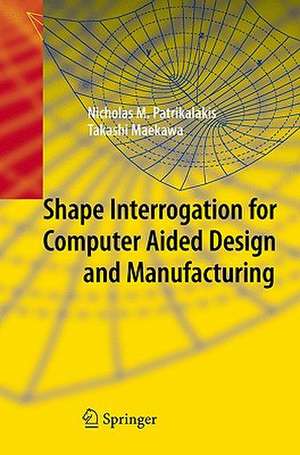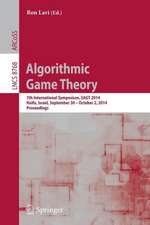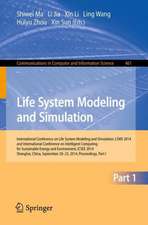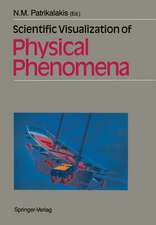Shape Interrogation for Computer Aided Design and Manufacturing
Autor Nicholas M. Patrikalakis, Takashi Maekawaen Limba Engleză Paperback – 28 feb 2010
| Toate formatele și edițiile | Preț | Express |
|---|---|---|
| Paperback (1) | 317.81 lei 38-44 zile | |
| Springer Berlin, Heidelberg – 28 feb 2010 | 317.81 lei 38-44 zile | |
| Hardback (1) | 513.56 lei 6-8 săpt. | |
| Springer Berlin, Heidelberg – 14 feb 2002 | 513.56 lei 6-8 săpt. |
Preț: 317.81 lei
Preț vechi: 397.27 lei
-20% Nou
Puncte Express: 477
Preț estimativ în valută:
60.81€ • 63.66$ • 50.32£
60.81€ • 63.66$ • 50.32£
Carte tipărită la comandă
Livrare economică 01-07 aprilie
Preluare comenzi: 021 569.72.76
Specificații
ISBN-13: 9783642040733
ISBN-10: 364204073X
Pagini: 424
Ilustrații: XVI, 408 p. 173 illus., 8 illus. in color.
Dimensiuni: 155 x 235 x 25 mm
Greutate: 0.59 kg
Ediția:1st ed. 2002, 2nd corr. printing. 2010
Editura: Springer Berlin, Heidelberg
Colecția Springer
Locul publicării:Berlin, Heidelberg, Germany
ISBN-10: 364204073X
Pagini: 424
Ilustrații: XVI, 408 p. 173 illus., 8 illus. in color.
Dimensiuni: 155 x 235 x 25 mm
Greutate: 0.59 kg
Ediția:1st ed. 2002, 2nd corr. printing. 2010
Editura: Springer Berlin, Heidelberg
Colecția Springer
Locul publicării:Berlin, Heidelberg, Germany
Public țintă
GraduateCuprins
Representation of Curves and Surfaces.- Differential Geometry of Curves.- Differential Geometry of Surfaces.- Nonlinear Polynomial Solvers and Robustness Issues.- Intersection Problems.- Differential Geometry of Intersection Curves.- Distance Functions.- Curve and Surface Interrogation.- Umbilics and Lines of Curvature.- Geodesics.- Offset Curves and Surfaces.
Recenzii
From the reviews:
"... Currently there are several excellent books in the area of geometric modeling and in the area of solid modeling. The major contribution of this book lies in its skilful manner of providing a bridge between these two areas that is guaranteed to make the target audience cry out aloud with delight. Apart from the differential geometry topics covered, the entire book is based on the unifying concept of recasting all shape interrogation problems to the solution of a nonlinear system. Indeed the book is quite compulsive; No study of shape interrogation can ignore Patrikalakis and Maekawa's. Nearly 460 references to the literature make the book widely welcomed. ..."
Current Engineering Practice 2002-2003, Vol. 45, Issue 3-4
"... It provides a comprehensive coverage of the fundamental concepts that shape interrogation techniques rely on as well as of the various techniques and algorithms for interrogation of shape features. ... Containing 408 pages, the book can be an indispensable reference for anybody with interest in this field of computer aided geometric design and software development. Nick Patrikalakis and Takashi Maekawa, researchers at MIT, managed to presnet all related concepts in an insightful way. The careful arrangement of the topics and the endeavor of the authors to recast all shape interrogation problem to the numerical solution of a nonlinear system of equations impressed the reviewer. ..."
I. Horváth, Structural and Multidisciplinary Optimization 2003, Vol. 24, Issue 6
"…this is a very detailed and complete book on topics that are important in both the theory and practice of geometric modeling. It is a welcome addition to the literature. Reading it and experimenting with the techniques it describes should be a rewarding experience."
Luiz Henrique de Figueiredo, MATHEMATICAL REVIEWS
"... This book by Patrikalakis andMaekawa is the first thorough, long overdue, look at this curicial area. The book presents an original and inclusive summary of advanced computational topics that relate to the geometry of freeform shapes. Research in these computational areas has matured to a point where such a compendium is no longer nice to have on one's shelf, but a necessity for the serious investigator. The book handles computational problems that represent fundamental components in any solid modeling environment, filling a vacuum in the literature. It will serve well any researcher, either in academia or industry, working in the area of freeform design or manusfacturing. This work continues from the point where the traditional geometric design and solid modeling books stop. ...
Shape interrogation and computational geometry of freeform shapes have been a part of the geometric design and manufacturing community for a long time. This book makes efforts and is likely to become the 'Bible' for this area. As a high-quality produced book, it is a must reference for any advanced researcher or developer who works with splines and freeform representations. If you consider yourself one, this book should probably be on your bookshelf. I eagerly await what the first revision of this book may yield."
Gershon Elber, Computer-Aided Design 35 (2003) 1053
"‘Shape Interrogation’ in general means the process of extracting information from a geometric model. … The aim of this text is to provide an exhaustive list of tools and algorithms useful for shape interrogation of freeform curves and surfaces. Their effectivity depends on the end user’s capability of solving systems of nonlinear equations, which is one reason for the author’s focus on robust polynomial solvers." (Johannes Wallner, Zentralblatt MATH, Vol. 1035, 2004)
"‘Shape Interrogation’ is the process of extracting information from a geometric model. … This bookprovides a bridge between the areas of geometric modeling and solid modeling. Apart from the differential geometry topics covered, the entire book is based on the unifying concept of recasting all shape interrogations problems to the solution of a nonlinear system. … The book can serve as a textbook for teaching advanced topics of geometric modeling for graduate students as well as professionals in industry." (deslab. mit.edu, October, 2003)
"This book gives a detailed description of algorithms and computational methods for shape interrogation … . The book can be used in a course for advanced graduate students and also as a reference text for researchers and practitioners in CAD/CAM. … is a very detailed and complete book on topics that are important in both the theory and the practice of geometric modeling. It is a welcome addition to the literature. Reading it and experimenting with the techniques it describes should be a rewarding experience." (Luiz Henrique de Figueiredo, Mathematical Reviews, 2003 a)
"Shape interrogation and computational geometry of free-form shapes have been a part of the geometric design and manufacturing community for a long time. This book makes a first triumphant attempt at summarizing these research efforts and is likely to become the ‘Bible’ for this area. As a high-quality produced book, it is a must reference for any advanced researcher or developer who works with splines and freeform representations. If you consider yourself one, this book should probably be on your bookshelf." (Gershon Elber, Computer Aided Design, Vol. 35, 2003)
"The book focuses on the topic of getting shape information from the geometric models of sculptured objects. … Containing 408 pages, the book can be an indispensable reference for anybody with interest in this field of computer aided geometric design and software development. … the text is sufficiently illustrated with figures and the production of the book is of goodquality. … The book can be offered as a textbook for teaching advanced topics of geometric modeling for graduate students." (I. Horváth, Structural and Multidisciplinary Optimization, Vol. 24 (6), 2003)
"This book provides the mathematical fundamentals as well as algorithms for various shape interrogation methods including nonlinear polynomial solvers, intersection problems, differential geometry of intersection curves, distance functions, curve and surface interrogation, umbilics and lines of curvature, geodesics, and offset curves and surfaces. … The book will inform and enlighten professionals in industry and therefore remains essential reading for them too." (Current Engineering Practice, Vol. 45 (3-4), 2002-03)
"... Currently there are several excellent books in the area of geometric modeling and in the area of solid modeling. The major contribution of this book lies in its skilful manner of providing a bridge between these two areas that is guaranteed to make the target audience cry out aloud with delight. Apart from the differential geometry topics covered, the entire book is based on the unifying concept of recasting all shape interrogation problems to the solution of a nonlinear system. Indeed the book is quite compulsive; No study of shape interrogation can ignore Patrikalakis and Maekawa's. Nearly 460 references to the literature make the book widely welcomed. ..."
Current Engineering Practice 2002-2003, Vol. 45, Issue 3-4
"... It provides a comprehensive coverage of the fundamental concepts that shape interrogation techniques rely on as well as of the various techniques and algorithms for interrogation of shape features. ... Containing 408 pages, the book can be an indispensable reference for anybody with interest in this field of computer aided geometric design and software development. Nick Patrikalakis and Takashi Maekawa, researchers at MIT, managed to presnet all related concepts in an insightful way. The careful arrangement of the topics and the endeavor of the authors to recast all shape interrogation problem to the numerical solution of a nonlinear system of equations impressed the reviewer. ..."
I. Horváth, Structural and Multidisciplinary Optimization 2003, Vol. 24, Issue 6
"…this is a very detailed and complete book on topics that are important in both the theory and practice of geometric modeling. It is a welcome addition to the literature. Reading it and experimenting with the techniques it describes should be a rewarding experience."
Luiz Henrique de Figueiredo, MATHEMATICAL REVIEWS
"... This book by Patrikalakis andMaekawa is the first thorough, long overdue, look at this curicial area. The book presents an original and inclusive summary of advanced computational topics that relate to the geometry of freeform shapes. Research in these computational areas has matured to a point where such a compendium is no longer nice to have on one's shelf, but a necessity for the serious investigator. The book handles computational problems that represent fundamental components in any solid modeling environment, filling a vacuum in the literature. It will serve well any researcher, either in academia or industry, working in the area of freeform design or manusfacturing. This work continues from the point where the traditional geometric design and solid modeling books stop. ...
Shape interrogation and computational geometry of freeform shapes have been a part of the geometric design and manufacturing community for a long time. This book makes efforts and is likely to become the 'Bible' for this area. As a high-quality produced book, it is a must reference for any advanced researcher or developer who works with splines and freeform representations. If you consider yourself one, this book should probably be on your bookshelf. I eagerly await what the first revision of this book may yield."
Gershon Elber, Computer-Aided Design 35 (2003) 1053
"‘Shape Interrogation’ in general means the process of extracting information from a geometric model. … The aim of this text is to provide an exhaustive list of tools and algorithms useful for shape interrogation of freeform curves and surfaces. Their effectivity depends on the end user’s capability of solving systems of nonlinear equations, which is one reason for the author’s focus on robust polynomial solvers." (Johannes Wallner, Zentralblatt MATH, Vol. 1035, 2004)
"‘Shape Interrogation’ is the process of extracting information from a geometric model. … This bookprovides a bridge between the areas of geometric modeling and solid modeling. Apart from the differential geometry topics covered, the entire book is based on the unifying concept of recasting all shape interrogations problems to the solution of a nonlinear system. … The book can serve as a textbook for teaching advanced topics of geometric modeling for graduate students as well as professionals in industry." (deslab. mit.edu, October, 2003)
"This book gives a detailed description of algorithms and computational methods for shape interrogation … . The book can be used in a course for advanced graduate students and also as a reference text for researchers and practitioners in CAD/CAM. … is a very detailed and complete book on topics that are important in both the theory and the practice of geometric modeling. It is a welcome addition to the literature. Reading it and experimenting with the techniques it describes should be a rewarding experience." (Luiz Henrique de Figueiredo, Mathematical Reviews, 2003 a)
"Shape interrogation and computational geometry of free-form shapes have been a part of the geometric design and manufacturing community for a long time. This book makes a first triumphant attempt at summarizing these research efforts and is likely to become the ‘Bible’ for this area. As a high-quality produced book, it is a must reference for any advanced researcher or developer who works with splines and freeform representations. If you consider yourself one, this book should probably be on your bookshelf." (Gershon Elber, Computer Aided Design, Vol. 35, 2003)
"The book focuses on the topic of getting shape information from the geometric models of sculptured objects. … Containing 408 pages, the book can be an indispensable reference for anybody with interest in this field of computer aided geometric design and software development. … the text is sufficiently illustrated with figures and the production of the book is of goodquality. … The book can be offered as a textbook for teaching advanced topics of geometric modeling for graduate students." (I. Horváth, Structural and Multidisciplinary Optimization, Vol. 24 (6), 2003)
"This book provides the mathematical fundamentals as well as algorithms for various shape interrogation methods including nonlinear polynomial solvers, intersection problems, differential geometry of intersection curves, distance functions, curve and surface interrogation, umbilics and lines of curvature, geodesics, and offset curves and surfaces. … The book will inform and enlighten professionals in industry and therefore remains essential reading for them too." (Current Engineering Practice, Vol. 45 (3-4), 2002-03)
Textul de pe ultima copertă
Shape interrogation is the process of extraction of information from a geometric model. It is a fundamental component of Computer Aided Design and Manufacturing (CAD/CAM) systems. The authors focus on shape interrogation of geometric models bounded by free-form surfaces. Free-form surfaces, also called sculptured surfaces, are widely used in the bodies of ships, automobiles and aircraft, which have both functionality and attractive shape requirements. Many electronic devices as well as consumer products are designed with aesthetic shapes, which involve free-form surfaces. This book provides the mathematical fundamentals as well as algorithms for various shape interrogation methods.
From the reviews:
"This book provides the mathematical fundamentals as well as algorithms for various shape interrogation methods including nonlinear polynomial solvers, intersection problems, differential geometry of intersection curves, distance functions, curve and surface interrogation, umbilics and lines of curvature, geodesics, and offset curves and surfaces. [… ] It may well be one of the most important books of the 2002s that has been written on shape interrogation for graduate students in mathematics, engineering, computer science, focusing on geometrical modeling and solid modeling. The book will inform and enlighten professionals in industry and therefore remains essential reading for them too. Currently there are several excellent books in the area of geometric modeling and in the area of solid modeling. The major contribution of this book lies in its skilful manner of providing a bridge between these two areas that is guaranteed to make the target audience cry out aloud with delight."
Current Engineering Practice 2002-2003, Vol. 45, Issue 3-4
"This book gives a detailed description of algorithms and computational methods for shape interrogation [… ] The book can be used in a course for advanced graduate students and also as areference text for researchers and practitioners in CAD/CAM. [… ] is a very detailed and complete book on topics that are important in both the theory and the practice of geometric modeling."
L. Henrique de Figueiredo, Mathematical Reviews 2003 a
"... This book by Patrikalakis and Maekawa is the first thorough, long overdue, look at this crucial area. [… ] It will serve well any researcher, either in academia or industry, working in the area of freeform design or manufacturing. This work continues from the point where the traditional geometric design and solid modeling books stop. ... Shape interrogation and computational geometry of freeform shapes have been a part of the geometric design and manufacturing community for a long time. This book makes efforts and is likely to become the 'Bible' for this area. As a high-quality produced book, it is a must reference for any advanced researcher or developer who works with splines and freeform representations. If you consider yourself one, this book should probably be on your bookshelf."
G. Elber, Computer-Aided Design 35 (2003) 1053
From the reviews:
"This book provides the mathematical fundamentals as well as algorithms for various shape interrogation methods including nonlinear polynomial solvers, intersection problems, differential geometry of intersection curves, distance functions, curve and surface interrogation, umbilics and lines of curvature, geodesics, and offset curves and surfaces. [… ] It may well be one of the most important books of the 2002s that has been written on shape interrogation for graduate students in mathematics, engineering, computer science, focusing on geometrical modeling and solid modeling. The book will inform and enlighten professionals in industry and therefore remains essential reading for them too. Currently there are several excellent books in the area of geometric modeling and in the area of solid modeling. The major contribution of this book lies in its skilful manner of providing a bridge between these two areas that is guaranteed to make the target audience cry out aloud with delight."
Current Engineering Practice 2002-2003, Vol. 45, Issue 3-4
"This book gives a detailed description of algorithms and computational methods for shape interrogation [… ] The book can be used in a course for advanced graduate students and also as areference text for researchers and practitioners in CAD/CAM. [… ] is a very detailed and complete book on topics that are important in both the theory and the practice of geometric modeling."
L. Henrique de Figueiredo, Mathematical Reviews 2003 a
"... This book by Patrikalakis and Maekawa is the first thorough, long overdue, look at this crucial area. [… ] It will serve well any researcher, either in academia or industry, working in the area of freeform design or manufacturing. This work continues from the point where the traditional geometric design and solid modeling books stop. ... Shape interrogation and computational geometry of freeform shapes have been a part of the geometric design and manufacturing community for a long time. This book makes efforts and is likely to become the 'Bible' for this area. As a high-quality produced book, it is a must reference for any advanced researcher or developer who works with splines and freeform representations. If you consider yourself one, this book should probably be on your bookshelf."
G. Elber, Computer-Aided Design 35 (2003) 1053
Caracteristici
Two top authors of MIT present a textbook on CAD and geometrical modelling One of the few textbooks in the field













